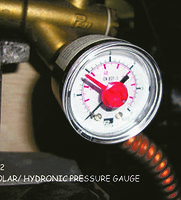Solar, hydronic fluids and pressures

Solar heat collectors are commonly installed as "Closed-Loop Pressurized-Glycol" systems in cold climates where freezing weather exists. (The majority of our solar heating projects installed in recent years have been designed this way.) In point of fact, there are actually three separate piping systems that make up one of these typical solar heating systems because there are three separate pressurized liquids circulating within a standard solar/hydronic combisystem. This leads to certain requirements, consequences and details in the plumbing configuration that deserve some extra consideration. Here is a brief discussion of some of the relevant details involved when bringing together multiple pressurized liquids in a single combisystem.
Example: A typical solar combisystem
A piping diagram for a typical solar/hydronic combisystem can be seen in Figure 79-1. This is based on the “New Standard” piping configuration that we have been using in nearly all our solar combisystem installations in recent years. Notice that there are, in fact, three different fluids operating under independent conditions of pressure and temperature.
The solar glycol loop seen in red. It is a closed loop filled with a pressurized mixture of propylene glycol and water, which provides freeze protection for all the hydronic piping that extends outdoors.
The boiler fluid loop seen in black. This is also a closed loop filled with “boiler fluid” that circulates throughout the heating system indoors, consisting of plain water maintained within the range of pressure that is consistent with the requirements of the "hot water boiler."
The domestic hot water (DHW) plumbing system seen in green. This is an open system of plumbing that receives cold potable domestic water from the water main and sends hot water to the building after heating it in an “indirect” DHW tank. The potable water pressure in this system is typically twice as high as the water pressure in the boiler fluid.
The solar glycol loop
Our typical solar glycol loop, like the one seen in Figure 79-1, operates within the same pressure range as a “hot water boiler” system; normally around 15 – 25 psi. The solar loop can withstand much higher pressures during high temperature events, and a relief valve must be provided for safety, usually set to blow off at around 70 to 80 psi. This is over twice the blow-off pressure for a typical hydronic boiler.
Since the solar glycol loop is a closed loop it requires its own diaphragm expansion tank (the red expansion tank). This expansion tank may be used for three different purposes during normal operation. (1) It provides an air cushion so that the liquid in the closed loop can expand and contract with temperature within a safe and consistent range of pressure. (2) It can provide a small amount of make-up fluid to refill the system when small amounts of air are released from air vents. And (3) this tank may also be sized to allow steam-back overheat protection during power failures.
In our typical Standard Combisystem, a single-wall heat exchanger is used between the solar loop and the boiler primary loop. A brazed-plate stainless steel heat exchanger is most often used here, seen as half red and half black on the diagram. This serves three important purposes. (1) Solar Heat is allowed to pass from the solar loop into the boiler primary loop, (2) the solar glycol fluid remains separated from the boiler fluid water so the indoor fluid and the outdoor fluid never mix, and (3) the boiler primary loop is isolated and protected from the higher pressures allowed in the solar loop.
A manual pressure gauge should always be mounted on the solar loop, as seen in Figure 79-2, so that anyone can easily check that the glycol pressure is within the proper operating range. Also, in our more recent systems we have also been installing an electronic pressure sensor that connects to our internet-enabled control systems so that we can watch the pressure remotely and receive pressure alarms from the controls system. A good location for the pressure gauge and sensor is labeled P1 in red. A typical pressure sensor installation can be seen in Figure 79-3.
The boiler fluid water loop
Our New Standard solar combisystem uses a primary loop in the mechanical room that connects all the heat sources and all the heating loads together in the proper temperature order. The primary loop and all the secondary loops can be seen in Figure 79-1 shown in black. All of this indoor hydronic plumbing is filled with plain water supplied by an Auto-Refill system that provides makeup water at a reduced pressure using a regulator set at 12 – 15 psi. This is a closed loop of boiler fluid, and when the system is hot, the boiler fluid expands into the boiler expansion tank (the black one) to maintain a normal operating pressure that rarely exceeds 25 psi when everything is sized and adjusted correctly. Modulating and condensing boilers are frequently installed in systems like this with pressure relief valves set to blow off at 30 psi.
Notice that the (pressurized) heat storage water tank in this system is filled with boiler fluid (water) and does not require a heat exchanger since hot water from the tank can be delivered directly into the primary loop at a high thermal efficiency. This lowers the cost for the tank and the fluid. Also, the storage tank is connected on a secondary loop so that it can be used or bypassed easily simply by turning its circulator pump on or off. There are other ways to configure a heat storage tank, but this approach has proven itself over the years as being practical, low maintenance, efficient and reliable.
To monitor the pressure in the Boiler Fluid, we always install a pressure gauge and a pressure sensor (for remote monitoring) in the primary loop. A typical location is labelled on the diagram as P2 in blue.
The DHW open loop
One of the most important jobs performed by a solar combisystem is to heat the domestic hot water (DHW) in the building using solar direct, solar stored or boiler heat as needed. The typical DHW supply pressure may be 40 to 60 psi, and that is the pressure you can expect in the DHW plumbing system seen on the diagram in green. The DHW system is an “open” system which means that new, fresh water is constantly passing through as hot water is consumed in the building. This means that all the green plumbing components are exposed to an endless supply of oxygen and minerals that are commonly contained in potable water. So, it is common practice to design the DHW plumbing section with components that resist corrosion and can withstand the presence of minerals.
A heat exchanger coil is required to separate the high pressure on the potable side from the lower pressure required in the primary loop. An in-tank coil is recommended as our standard equipment (as seen on the diagram) since it is more resistant to the effects of mineral build-up compared to other types of DHW heat exchangers. The oxygen-resistant components are required here, such as bronze, stainless steel and porcelain coatings rather than cast iron or exposed mild steel.
We don’t usually monitor the pressure of the potable water with our heating system controls, but every DHW tank must have a pressure relief valve for safety, and these are typically set to blow off at 150 psi. Manual pressure and temperature gauges may always be installed here for convenience, and we always monitor the temperatures in the DHW system as part of our standard control system.
he importance of pressure
The pressure gauge is often the first thing you look at when doing a service inspection of a solar/hydronic heating system. Each pressurized fluid has a normal range of operation, and the pressure gauge can quickly reveal a leak or malfunction. Fluid may boil prematurely or allow air bubbles to accumulate if pressure is too low. Circulator pumps may fail prematurely as a result of low-pressure conditions. Relief valves may blow off or cause damage if fluid pressure is too high. The hydronic fluids in this system are just as important as the refrigerant in an air conditioner and there should be zero tolerance for leaks. The fluid pressure provides the first indication of impending failure.
Pressure data can tell a story
While a pressure gauge will give you a snapshot of your heating system, a pressure sensor (as seen in Figure 79-3) can allow you to watch the whole movie when it is connected to a data logging system with remote access. When recorded and viewed over time, pressure data from a hydronic heating system can reveal intermittent events that cannot be seen on a manual gauge. You can see "pressure signatures" over time such as overheat events, expansion tank malfunction, and progressive leaks or heat exchanger failures. This is why we now include pressure sensors that can be recorded and monitored remotely by our controls systems along with the traditional manual pressure gauges.
Final notes
These articles are targeted toward residential and small commercial buildings smaller than ten thousand square feet. The focus is on pressurized glycol/hydronic systems since these systems can be applied in a wide variety of building geometries and orientations with few limitations. Brand names, organizations, suppliers and manufacturers are mentioned in these articles only to provide examples for illustration and discussion and do not constitute any recommendation or endorsement. l
Bristol Stickney has been designing, manufacturing, repairing and installing solar hydronic heating systems for more than 30 years. He holds a Bachelor of Science in Mechanical Engineering and is a licensed Mechanical Contractor in New Mexico. He is the Chief Technical Officer for SolarLogic LLC in Santa Fe, N.M., where he is involved in development of solar heating control systems and design tools for solar heating professionals. Visit www.solarlogicllc.com for more information.





